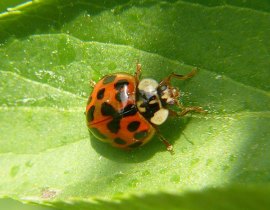Professional Pest Control & Wildlife Management
Harlequin Ladybirds
Ladybirds Harmonia axyridis have always been a welcome sight in the garden as they feed on aphids, unfortunately the UK has a new immigration problem – Harlequin Ladybirds. Harlequins arrived in Britain in 2004 and have been extremely successful in colonising the UK, they come in various disguises and are often mistaken for native species.
If you would like to arrange an appointment, need some advice or would like to ask us a question please fill in our enquiry form or call us on 0800 046 7433.
-
Treatment
Harlequin Ladybirds are a relatively new ‘pest’, however they can be treated with insecticides successfully.
Our Harlequin treatment includes first removing the infestation physically (a hoover works very well!), we then clean the areas where they congregate with a solution to remove the pheromone scent trails which they follow. Our next step is to apply a residual insecticide (if applied in direct sunlight the insecticide will break down faster) which will stay active for upto two months killing insects which cross over it. Lastly we fill any gaps or holes which allow access.
Due to the rapid breeding rate of these insects we would advise that a single treatment is unlikely to last an entire year.
-
Life Cycle
Harlequinns often hibernate in our homes congregating around window sills, they enjoy the warmth from the sun on the glass and will ‘hide up’ in the joins between window and frame.
Ladybirds lay eggs which then hatch into larvae, which then pupate and hatch into adult form. Female Harlequins can lay over thousand eggs in their lifetime, and become fertile and start laying eggs just five days into adulthood.
They feed upon aphids, other smal insects – including native ladybirds, honey dew and other sugary substances.
- False Widow Spider Removal
- Cluster Fly help
- The trouble with fleas?
- Mole Catching in Suffolk
- Rats in the Garden
- Wasp Nest Control
- Rats in your chicken Coop
- Anaphylaxis
- Bee Swarms
- Becoming a Beekeeper
- Rare Breed Poultry
- Pest Control with Birds of Prey
- Un-marked vehicles available
- Rabbiting with Ferrets
- Myxomatosis
- Poll-Tex Mesh
- Honorary Member Russell Wallis
- Free Rabbit Control


